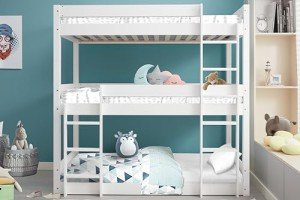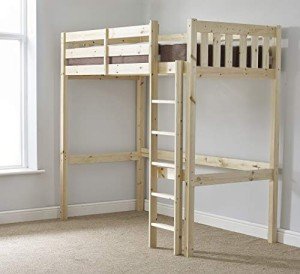Five Killer Quora Answers To Childrens Twin Bunk Beds
Madge
10мӢңк°„ 49л¶„м „
2
0
ліёл¬ё
 Childrens Twin Bunk Beds
Childrens Twin Bunk BedsFurniture for children is a common feature of twin bunk beds. They are extremely versatile and can grow along with teenagers through the years.
When you are choosing a bunk bed for your kids, consider their size, age and room layout. Ensure the bunk bed fits your child's mattress and has adequate headroom. Consider how the beds could be used to create separate rooms for two brothers sharing a room.
Size
Bunk beds are a space-saving solution for rooms with children. They let space be occupied by twin foundations, mattresses and box springs. Bunk beds also offer the opportunity to add storage options like drawers or trundles that are built-in. Bunk beds are available in classic Mission designs as well as contemporary and transitional styles that blend solid wood construction that is durable and modern and elegant finishes.
Take into consideration the height of the top cheap childrens bunk beds when selecting a twin bunk bed suitable for children. This will ensure that your child can safely sleep there. Take into consideration their height at present and how tall they'll likely grow in the next few years. Also, be sure to consider how confident they are at maneuvering around furniture. You can assess their comfort and ability to move around furniture by observing how they play with the outdoor playground equipment.
Most standard bunk beds fit the twin mattress, which measures 38 inches wide by 75 inches long. For older kids or teens choose a Twin XL bunk bed to accommodate their larger legs. A Full over Queen bunk bed which fits a queen-size mattress, is a great option for kids with more of a gap in age or siblings sharing rooms.
Choose a low-profile Twin Over Twin bunk bed for younger children. This will provide them with plenty of headroom in the bottom bunk. A majority of these models come with side ladders or stairs on the side or front of the bed. For a safer climb you should choose a bunk bed that has stairs with angled ladders, steps or front guardrails.
To have a more roomy sleeping arrangement, choose a Triple Twin over a Queen bunk bed that can accommodate three or two adults to rest comfortably. These are great for sharing rooms for children or as the ultimate sleepover headquarters. Several of these options have the added feature of an ideal desk space underneath the bunk, perfect for studying, homework or childrens twin bunk beds play. The Honey Mission Twin Over Full Stair Stepper cool childrens bunk beds bed is a great illustration of a stylish, practical bed that comes with a sturdy desktop.
Material
Many bunk bed styles use wood, which lends warmth and a classic look to a child's bedroom. Certain models feature metal frames that create a minimalist, sleek look. Bunk beds are available with a variety of twin mattresses. The most popular configuration is twin over twin, which takes the smallest amount of floor space and allows two children to share a room. The twin over full bunk is a popular option. It can be used to accommodate two teenagers or older children who want a larger sleeping area.
There are also bunk beds with different types of trundle beds, which are ideal for adding more sleeping space without taking up too much room in the child's bedroom. Some trundle beds can accommodate the addition of a third mattress on top. Others feature an opening drawer that is ideal for storing blankets and pillows. Bunk beds with the futon can be transformed into a comfortable seating area for guests.
If you are looking for a full or twin childrens mid sleeper bunk beds, you are able to pick from a variety of finishes and colors. White bunk beds are an excellent option for any interior design style. Bunks built with solid birch are a fantastic option for those looking for a traditional bunk bed that's also extremely durable. Oak, espresso and gray finishes are also in line with traditional bunk bed designs and create a contemporary look.
While it is important to think about a bunk bed's material when making your purchase, the overall quality of the furniture is just as important. A sturdy construction is necessary for bunk beds designed for children. They must be able to stand up to years and years of use. Pick bunk beds that are made of quality wood that will last or steel frames that are easy to keep clean and rust-resistant.
Bunk beds can be customized with a range of features like ladders that can be attached and stairs that allow children to climb to the upper sleep area. Some styles feature themed designs, like Mickey Mouse or Star Wars to help them blend in with the decor of a kid's bedroom.
Style
When it comes to childrens bedroom bunk beds twin bunk beds, it's not only about aesthetics. It also considers the diverse demands of families with children of different ages. A twin over full configuration, for instance, is a great solution for families with children of various age groups. It combines a twin-sized bed on top with a full-sized bed on the bottom.
Bunk beds are available in a wide range of styles to match any style of interior from the rustic feel of a farmhouse or country-style home to the sleek modernity of modern apartments and condos. Some bunk beds are equipped with storage space to maximize space and can accommodate the needs of children's individual needs for example, shelves, desks, or toys.
Additionally the design of children's twin bunk beds helps create an atmosphere of shared intimacy between siblings, which helps to build a stronger bond through sleep. The horizontal freedom of the design sparks their imagination and can inspire them to turn their beds into forts, spacecraft projects, or castles - creating an unbreakable bond with one and lasting for the rest of their lives.
In addition the childrens bunk beds that separate bed's versatility and functionality transcends the age of a child's life; they can be utilized by adults as well. Some bunk beds come with a pull-out futon to accommodate guests or other loved ones.
It is crucial to know whether your children are ready to the test. Your children should be competent enough to climb the ladder or stairs with ease and understand the safety precautions. In addition, if you have a child who has limited mobility, then bunk beds may not be the ideal choice for their room.
The attraction of twin bunk beds over full bunks is their adaptability. Not just for rooms for children and dormitories, they are now commonplace in vacation homes, cozy cabins, and even urban flatshares. They're a great way to make the most of small living spaces and easily transform into multifunctional bedrooms that double as study areas, play zones, and social hubs.
Safety
Bunk beds are a great way to free up space in shared bedrooms. However, they have to be considered in conjunction with safety concerns. These precautions are designed to prevent injuries and accidents that result from falls, entrapment, and other hazards. By taking the time to put up and maintain bunk beds, providing appropriate supervision and teaching children healthy sleeping habits, you can minimize these risks.
Age restrictions: Children should only use the top bunk of a bunk bed when they are 6 years or older and possess the physical coordination and judgement to safely use it. A bunk bed is not recommended for young children as they may fall or get trapped when trying to climb on the ladder.
Ladder installation: The ladder should be firmly secured to the bunk frame and placed at an appropriate angle to prevent it from falling or tipping. It is essential that children are taught how to use the ladder correctly and to discourage horseplay around or on the ladder. It is important to inspect the ladder on a regular basis for signs of wear, and tighten or replace any loose parts.
Rail placement: To prevent falls, the safety rails must be placed on the sides of the upper bunk. They should also be installed at least 5 inches (13cm) above the surface of the mattress. Rails must be securely attached to the frame with no gaps or loose connections. The rails must be inspected often to ensure they're in good condition.
Guardrail gaps: The distance between the guardrails (and safety rails) should not exceed 3.5 inches (9cm) to prevent children from getting their heads or limbs caught in these gaps. To test the gap, a solid globe can be inserted into the gap to make sure it is not large enough to cause a neck or head entrapment.
 It is also a good idea to place the bed away from windows since this can stop children from climbing up or trying to reach the window sills, and possibly falling out of the window. Keep all toys and other clutter away from the bunk beds, as they can encourage dangerous behavior and make it hard for children to get to their sleeping areas.
It is also a good idea to place the bed away from windows since this can stop children from climbing up or trying to reach the window sills, and possibly falling out of the window. Keep all toys and other clutter away from the bunk beds, as they can encourage dangerous behavior and make it hard for children to get to their sleeping areas.
лҢ“кёҖлӘ©лЎқ0
лҢ“кёҖ нҸ¬мқёнҠё м•ҲлӮҙ